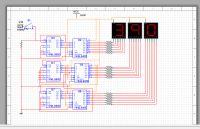Gentem
Junior Member level 1
Hi,
I have been a set a project to complete by the end of the month, I do not know much about sequential logic circuits or any other aspects that are mentioned in the brief, so that leaves me in an awkward position as I do not know how to even begin. :-( The only things I have learnt so far is some basics on flip-flops and timing diagrams, other than that, please help...
The brief:
You are required to design and build a circuit to display the frequency of a TTL compatible square wave. Frequency meters consist of a counter, a display and a gate that is opened and closed under the control of an accurate oscillator, plus some control. Your circuit should consist of three seven segment displays and indicate the frequency in the range 0 – 999 Hz. Your circuit should freeze the display when the gate closes so that it can be read, and reset it to zero before the gate opens again. It will therefore be necessary to design some gate and reset control circuitry, and possibly a latch.
Thank you for taking the time to read this, I hope someone can help.
Gentem
I have been a set a project to complete by the end of the month, I do not know much about sequential logic circuits or any other aspects that are mentioned in the brief, so that leaves me in an awkward position as I do not know how to even begin. :-( The only things I have learnt so far is some basics on flip-flops and timing diagrams, other than that, please help...
The brief:
You are required to design and build a circuit to display the frequency of a TTL compatible square wave. Frequency meters consist of a counter, a display and a gate that is opened and closed under the control of an accurate oscillator, plus some control. Your circuit should consist of three seven segment displays and indicate the frequency in the range 0 – 999 Hz. Your circuit should freeze the display when the gate closes so that it can be read, and reset it to zero before the gate opens again. It will therefore be necessary to design some gate and reset control circuitry, and possibly a latch.
Thank you for taking the time to read this, I hope someone can help.
Gentem







